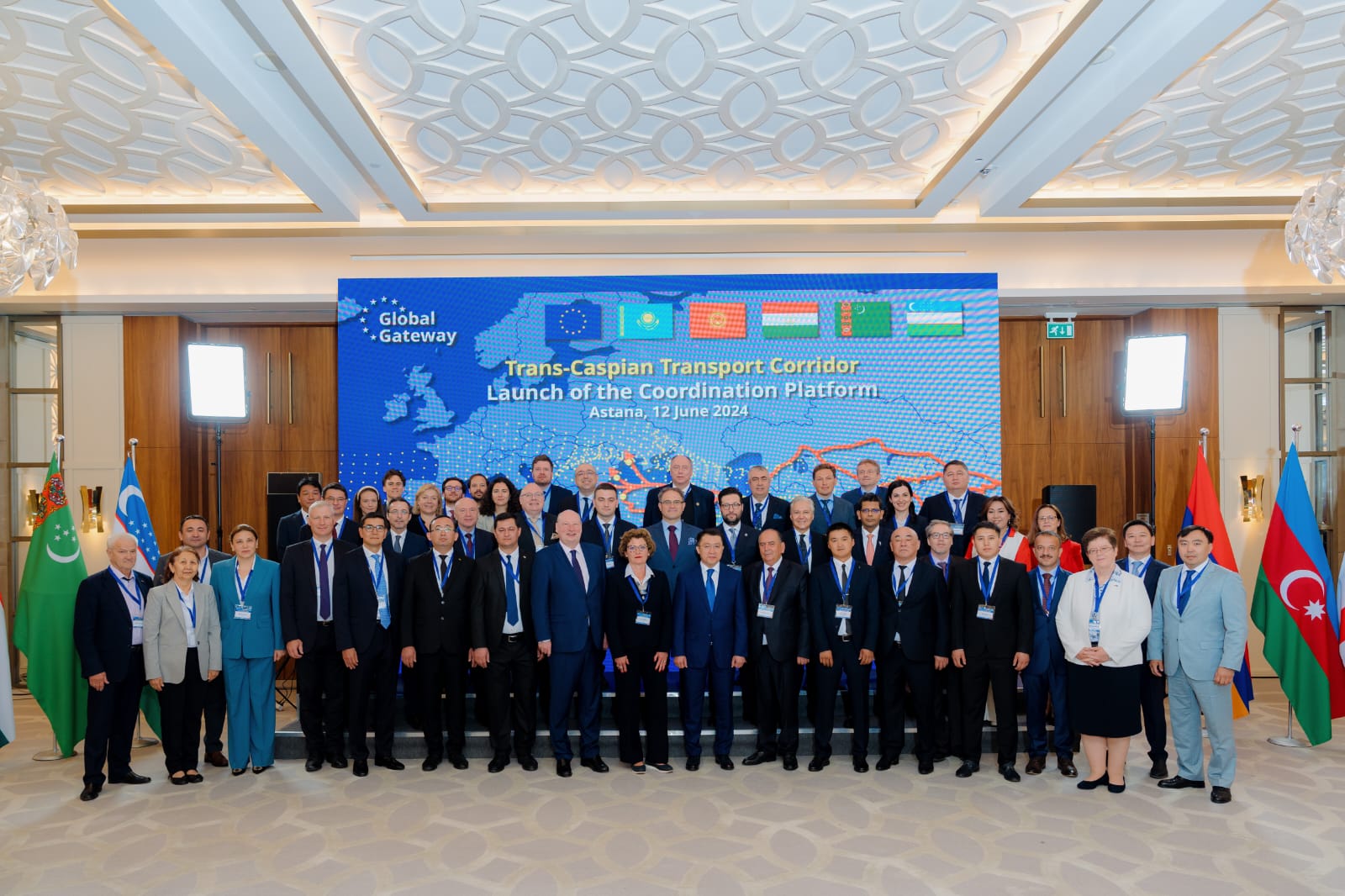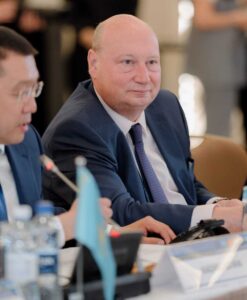ASTANA – Astana hosted the launch of a coordination platform for the Trans-Caspian International Transport Route (TITR) on June 12. The platform is designed to facilitate projects along TITR and connect all stakeholders in a broader effort to turn the corridor into a sustainable, competitive, and efficient route.

The event participants pose for a group photo before opening of the first session. Photo credit: EU Delegation to Kazakhstan
The platform brings together donors, investors, stakeholders, and beneficiaries involved in the TITR. Among them are the five Central Asian states: Armenia, Azerbaijan, Georgia, Turkiye, the European Commission, European Union (EU) member states, the European Investment Bank, the European Bank for Reconstruction and Development (EBRD), the World Bank, and the Asian Development Bank.
Its main tasks include mapping ongoing and planned initiatives, identifying soft infrastructure projects, monitoring the progress in the implementation of projects and coordinating technical assistance.

Minister Karabayev delivers remarks at the event. Photo credit: EU Delegation to Kazakhstan
Addressing the event, Kazakh Minister of Transport Marat Karabayev said that Kazakhstan, located at the crossroads of important trade routes, has long been aware of the importance of an efficient and sustainable transport system.
“The creation of a coordination platform is an important step in this direction, providing us with a unique opportunity to join forces, and share experiences and opinions to achieve common goals of the regions,” said the minister.
TITR connects China with Europe, traversing Kazakhstan, the Caspian Sea, Azerbaijan, Georgia, and Türkiye before reaching the European countries. The ministry’s data indicate cargo transportation along the TITR reached 2.75 million tons in 2023, growing by 65% compared to 2022.
Karabayev also expressed gratitude to the EU for its support in developing the corridor.
“The EU has been a reliable partner of the region for a long time, contributing to the improvement of infrastructure, strengthening economic affairs, and promoting sustainable development,” said Karabayev.
According to him, working together under the new platform will improve transport infrastructure, strengthen economic ties, increase the safety and sustainability of transport corridors, and accelerate the introduction of innovations and advanced technologies in the transport sector.

The launch of the platform is a major outcome since the Investors Forum in January in Brussels, where the European side announced commitments worth 10 billion euros to invest in sustainable transport connectivity in Central Asia. Photo credit: Aida Dosbergenova / The Astana Times
Deputy Foreign Minister Roman Vassilenko emphasized there is no time to lose. “You cannot beat geography, but you can make geography work for you. This is what we are embarking on in trying to recreate the great Silk Road of the past in modern circumstances,” said Vassilenko.
He stressed the need to “get to work” in delivering the commitments regarding the corridor development.
“All studies [on TITR] point to the same things: investments are needed, and investments are needed now to remove the bottlenecks along the Trans-Caspian transport corridor. Enough studies and let us indeed get to work. This coordination platform is a great platform,” he said.
According to him, the development of TITR has long-term implications for sustainable development and peace in Central Asia and the South Caucasus.
Henrik Hololei, Hors Classe Adviser at the European Commission’s Directorate-General for International Partnerships, said TITR is a flagship project for the Global Gateway strategy, an EU initiative aimed at strengthening connectivity between Europe and the rest of the world.

Henrik Hololei. Photo credit: EU Delegation to Kazakhstan
“The aim of the platform is to provide a permanent framework that will drive forward the implementation of projects in Central Asia in a consistent and coordinated way to achieve the long-term objective of making the Trans-Caspian corridor a more sustainable, safer and faster route linking Europe and Central Asia in less than 15 days,” said Hololei.
The platform is also meant to support investors and stakeholders in mobilizing the investments necessary for completing projects along the route. The study, conducted by the European Bank for Reconstruction and Development, estimates that 18.5 billion euros (US$19.9 billion) is needed.
He noted that the countries involved can turn TITR into a modern multimodal economic gateway. “This is undoubtedly the renaissance of the Silk Road, as the EU sees the Trans-Caspian transport corridor as a highly relevant route in the current geopolitical context. As in ancient times, it will also have the potential to be a corridor of ideas, knowledge, and innovation, in addition to connectivity and trade. It brings people and businesses along and around the corridor,” he said.
He stressed the importance of involving the private sector. The coordination platform plans to develop a private sector engagement plan by the end of this year.
“I can assure you that we are very aware that the success of the platform, as well as the overall success of the corridor, will depend on the solid engagement of private businesses. This is essentially an economic corridor and the significant economic driver for the whole of Central Asia and all countries along the corridor,” he added.
The European official reaffirmed the EU’s keen interest in deepening ties with Central Asia, saying that the relations “have gone from strength to strength.”
“This is supported by the many ambitious economic and societal reforms implemented in Central Asia over the past years, which affected the vastly and fast developing region. No doubt, the EU engagement with Central Asian countries at the political and strategic level has intensified substantially in recent years, and the connection across the Caspian Sea is strategic in many ways,” he said.

The coordination platform also presented its six-month work plan. Photo credit: Aida Dosbergenova / The Astana Times
With a population of nearly 75 million people and a large young population, the region offers many opportunities.
“Economic development is key for success, as is the diversification of the economies and embracing new, smart and sustainable solutions that can help to create more jobs and prosperity. I have observed the positive developments in this region and the drive for modernization and reforms. (…) It does not surprise me, when we look at the globe and see many geopolitical tensions and conflicts that Central Asia comes out as a region that is a pillar of stability, and one can witness positive developments and encouraging reforms amidst the volatile and challenging world we currently live in,” he said.
The draft six-month plan entails identifying projects for facilitation support between July and October, a ministerial-level launch in Turkmenistan in October, and the organization of expert workshops in the second half of 2024.
Long-term plans include the new EU regional transport program, which will become operational in early 2025, and the new EU—Central Asia Prosperity Program, which will be launched in the third quarter of 2024 and aims to support trade facilitation and digitalization.


